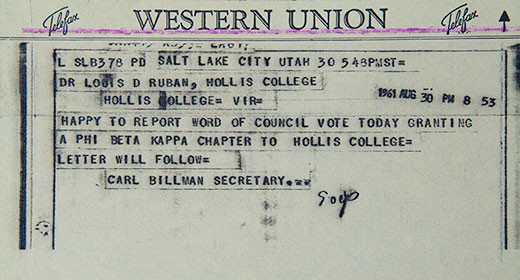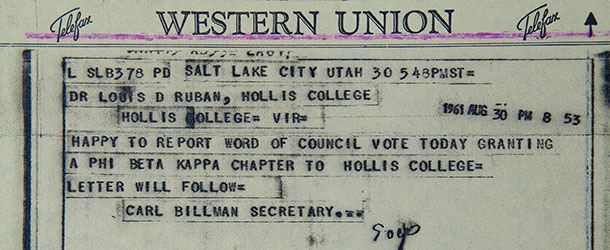
Fifty Years of Phi Beta Kappa

Telegram, complete with casual spelling, announcing the vote to approve Hollins’ bid for a chapter.
It took three tries, but Hollins’ persistence paid off. In 1961, the college’s application for a Phi Beta Kappa chapter finally got the green light, and the Iota of Virginia chapter was installed the following spring.
Getting into Phi Beta Kappa, the nation’s most prestigious academic honorary society, means you’ve worked hard and proved yourself to a tough audience. Sometimes there are setbacks in your academic endeavors, but you overcome them, learn from your mistakes, and with some luck are rewarded for your achievements.
Hollins followed a similar trajectory in its quest for its own Phi Beta Kappa chapter. Presidents submitted applications several times—in 1947-48, 1953-54, and 1959-60. Phi Beta Kappa’s membership committee rejected the first two applications (the primary reason given was the high attrition rate from sophomore to junior year, not uncommon at women’s colleges in the 1940s and ’50s) and tabled the third because Hollins was experiencing a transition in presidents. But thanks to the efforts of a hard-working group of Phi Beta Kappans among the faculty, including Louis D. Rubin, Jr., chair of the English department, Hollins’ final bid eventually succeeded, in September 1961. Rubin’s letter to Carl Billman, secretary of the national organization, expressed his delight: “It has been a long, uphill struggle, and there were times when we wondered, but now that it has come about, it seems well worth the trouble.”
Other colleges recommended for chapters that year were Brandeis University, Chatham College, Fordham University, Lake Forest College, and Scripps College.
The installation of the Iota of Virginia chapter took place on February 20, 1962, under the direction of Hollins’ new president, John A. Logan, Jr. Four members of the class of 1962 were elected—Laura Singleton Garrett, Syma Lipschutz Kroll, Katharine Burwell Lowe, and Margaret Prince Shinnick. Eight alumnae were invited to become members: Anna Campbell 1907, Margaret Phelan Scott 1912, Rachel Wilson 1912, Marguerite Capen Hearsey 1914, Virginia Moore ’23, Mary Wells Knight Ashworth ’24, Mary Wood Whitehurst ’27, and Nan Cooke Carpenter ’34.
In a joyful moment, Rubin typed the following verse (the chorus of a longer response) in his reply to the formal invitation to the celebratory cocktail party and dinner:
 O the key o the key o the beautiful key
O the key o the key o the beautiful key
you and I you and I o how brainy we’ll be—
don’t go to Lexington
and don’t go to Charlottesville
win a key, win a beautiful key.
Hollins was the 171st college to be awarded a Phi Beta Kappa chapter. There are now 280 chapters at fewer than 10 percent of America’s colleges and universities. Over the past fifty years, 841 Hollins students have been elected to the organization. They have learned the secret handshake, many of them instructed in this practice by Professor of English R.H.W. Dillard, himself a Phi Beta Kappan, and they have promised, as their chapter sisters pledged fifty years ago, to “have paramount regard for moral character and scholarly achievement.”
—Jean Holzinger M.A.L.S. ’11, editor; treasurer of Iota of Virginia
On September 26, Hollins is hosting Phi Beta Kappa Visiting Scholar John Agnew, distinguished professor of geography and professor of Italian at UCLA. A specialist in immigration issues, Agnew will is a specialist in immigration issues.
